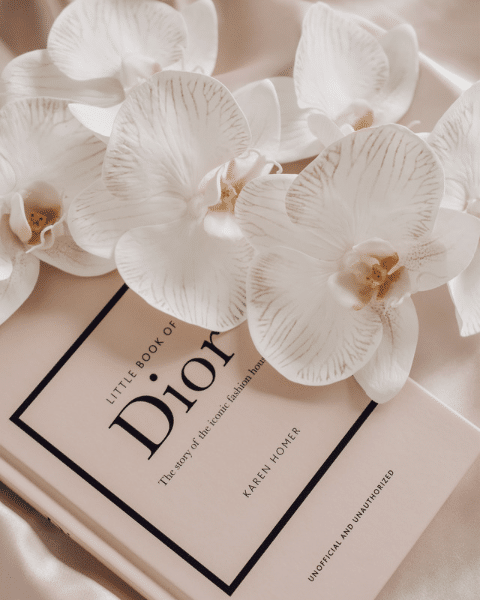“Don’t buy much but make sure that what you buy is good.” – Christian Dior
Brief Overview:
- French Luxury Fashion House
- Founder: Christian Dior (1905-1957)
- Founded: 1946
- Innovations:
- Introduced the “New Look” which celebrated ultra-femininity and opulence in women’s fashion.
- Revolutionised the women’s fashion industry.
- Transformed the wardrobe of the contemporary woman.
- Opulent, Glamorous & Feminine
Christian Dior Quotes:
- “The detail is as important as the essential is. When it is inadequate, it destroys the whole outfit.” – Christian Dior
- “Elegance must be the right combination of distinction, naturalness, care and simplicity. Outside this, believe me, there is no elegance. Only pretension.” – Christian Dior
- “It is not money that makes you well dressed: it is understanding.” – Christian Dior
The History of Dior
Dior was born in 1905 in the north of France; his family relocated to Paris when he was young. Dior opened a small art gallery in 1928, but he was forced to close it in 1931. Dior then started to sell his fashion sketches to make an income. In 1935 was approached by Figaro Illustré and offered/accepted a job as the magazine’s illustrator. Robert Piguet subsequently (Parisian couturier) employed Dior as a design assistant in 1938, but Dior left the post to serve the French army during WWII. In 1941, Dior returned to Paris and worked for Lucien Lelong.
Christian Dior created his namesake brand in 1946 but launched his debut collection in the Spring/Summer of 1947. The first collection was called “Corolle”, which means “a circlet of flower petals.” Dior once said, “After women, flowers are the most divine creations,” so it is no surprise that flowers influenced his debut collection. Dior is known to have reintroduced femininity and luxury to women’s fashion; his designs were controversial but vastly popular during a time of heavy wartime restrictions.
Dior’s brand quickly expanded to include more items, including the launch of a ready-to-wear house in 1948 and the launch of fragrance, accessories and furs. The first fragrance launched by the brand is the famed “Miss Dior” and was introduced alongside the Corolle Collection to celebrate the “new look.”
In 1957, Dior suddenly died at 52 after suffering a third heart attack. His funeral was a national event attended by about 2500 people, including his staff and many famous clients. In homage to the house’s 70th anniversary, the National Gallery of Victoria published The House of Dior: Seventy Years of Haute Couture, the 256-page coffee table book in 2017 showcasing the brand’s evolution.
Yves Saint Laurent, Dior’s former assistant, immediately succeeded him in 1957 as the world’s youngest couturier, aged 21. Saint Laurent was drafted into the army in 1960 and was replaced by Marc Bohan, who introduced the slim look to the womenswear collection. In 1989 Bohan was succeeded by Milan’s Gianfranco Ferré (the first foreign-born designer to take the reigns), who presented an architectural style to the design house. John Galliano took over from Gianfranco Ferré and introduced loose beading and drama until he was removed from the position in 2011. Bill Gaytten temporarily led the creative direction until he handed the responsibility to Raf Simons, who introduced a contemporary aesthetic to the brand. Simons resigned in 2015, and Maria Grazia Chiuri became the first female creative director of Dior in 2016 and is currently heading the brand (Kim Jones has headed the men’s creative direction since 2018).
Signature Styles & Iconic Designs
New Look, SS 1947
Dior’s debut collection introduced the “new look” in women’s fashion. The new look involved rounded shoulders, a fitted waist and a full skirt. The New Look reintroduced femininity, luxury and extravagance back to the women’s fashion scene after a period of military and civilian uniforms. The aesthetic was labelled “New Look” by Harper’s Bazaar Editor-In-Chief, who said about the collection: “It’s quite a revolution, dear Christian! Your dresses have such a new look!” The aesthetic is now a Dior trademark and has been adapted throughout history.
Lady Dior Bag, 1995
The Lady Dior bag made its debut adorned by Princess Diana in 1995. An architectural symbol of elegance debuted with lambskin, the iconic Cannage motif, and rounded handles. Still, it has been reinvented throughout history with Reinterpreted with charms, a wide shoulder strap, a more supple design, many colours, sizes, and ever-exceptional materials. It is a perennial style of the design house.
Each element of the bag is a nod to the label’s founder and history. The charms are inspired by Christian Dior’s personal lucky charms, and the quilting is a nod to Napoleon III’s chairs sat on by guests at Dior’s runways.
The Bar Suit, 1947
“The Bar Suit” is considered the most iconic item from the debut collection that gained the title “New Look.” The suit featured a white satin jacket, a dramatically cinched waist, a voluminous black A-line skirt, padded hips, and soft shoulders. The suit is a nod to Dior’s architectural background (he once wanted to be an architect). The suit takes more than 150 hours of work to give the illusion that it has been moulded onto a woman’s body.
Christian Dior Biographies
Books
- Dior by Christian Dior – Christian Dior
- Little Book of Dior: The Story of the Iconic Fashion House – Karen Holmer
- Christian Dior: Designer of Dreams – Florence Müller





